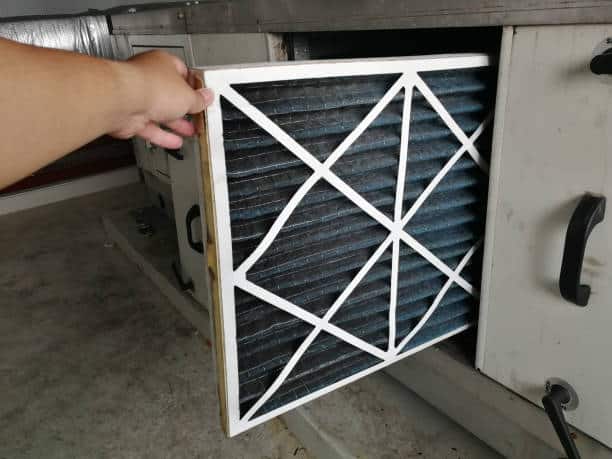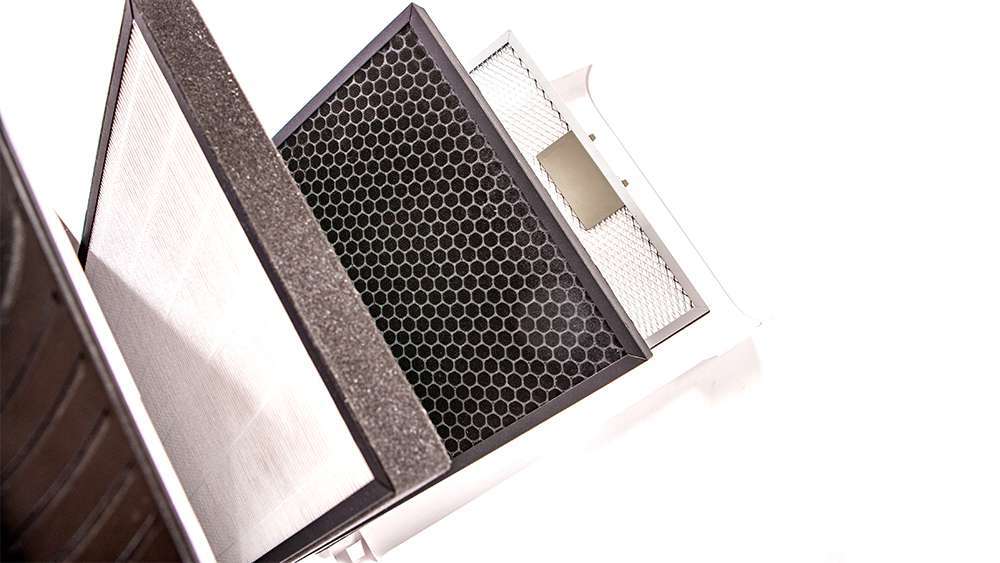Dust and filth start to enter your air conditioner when the filter is clogged, causing damage to the internal parts. In addition, the clogged filter hinders the system from receiving enough air to maintain proper operation. So how do you replace a filter in a central air conditioner?
Make sure you have the correct air filter replacement size before replacing the filter in your air conditioner. Afterward, to adjust the filter:
- Turn off the AC power.
- Remove the old AC filter.
- Verify the state of the filter.
- Dispose of the old filter safely.
- Get the filter clean.
- Activate the AC with the new filter.
Let’s discuss why you should do it and how to maintain your central AC unit filters now that you know how to change an air conditioner filter. Let’s also explore the significance of an air filter for your central air conditioning system.
Why Should You Replace the Filter In Your Central Air Conditioner?

Because they are the first line of defense in clearing air through the furnace’s filter for both heating and cooling, it is crucial to maintain your air filters on a regular basis. Filters that are blocked or dirty can affect the performance quality and energy efficiency of the central air system, causing it to overheat, overwork, and impair indoor air quality.
The following are some benefits of having fresh AC air filters:
- Keep the air in your house clean and free of allergens and dust.
- Save money on energy.
- Make your AC last longer.
How Long Does A Filter Last In A Central Air Conditioner?
The filter service has a lifespan that varies from one to six months depending on the filter. At least twice a year, if not more, should pass the filter. There are numerous basic and performance filters available.
To determine what will work best for your home and central air system, you can talk over your options with an HVAC contractor.
Where Typically Are Air Filters Found In A Central AC System?
In some systems, the return air duct houses the filters. This one transfers air from your room to your air conditioner’s air handler system. It could be challenging to locate the filters in a complicated system with numerous air handlers and return ducts.
If your heating and cooling systems use the same ductwork, it’s also likely that the air filter for both systems is situated in or close to the furnace’s blower system. If that’s the case, it’s typically near the front, at the bottom of the furnace.
Cleaning Reusable Air Filters

One method of keeping reusable air filters in good condition is to clean them. How do I clean a reusable air filter, you ask? Here is a how-to list:
- Clear the clogged filter out.
- Clean the surrounding surfaces and the frame with a cloth or vacuum.
- With a hose, clean the filter.
- The filter should be routinely soaked or scrubbed with a water-vinegar solution to remove bacteria buildup.
- Laissez le filtre sécher.
- Reinstall the filter in the device after it has dried.
What Sorts Of AC Air Filters Are There?
When browsing for HVAC filters, you’ll probably find a wide range of options in different types, sizes, and efficiency ratings. Filters can often be divided into two categories: reusable and disposable.
Here is a quick summary of the seven types of HVAC filters you can choose from if you’re thinking about upgrading to a more effective filter:

- HEPA Filter
- Ultraviolet Filters
- Fiberglass Filters
- Pleated Filters
- Media Filters
- Washable Filters
- Electrostatic Filters
The HEPA Filter
HEPA filters are those that have a MERV rating of 16 or higher. They are capable of removing even the smallest particles, including smoke from cigarettes, bacteria, and other impurities.
Pros:
- Fantastic technique to clean the air in your home.
- Both durable and economical.
Cons:
- It needs to be adjusted to fit your HVAC system.
- Defense against all scents, vapors, and gases is impossible.
- Initial investment expense that is high.
- Unsuitable for usage in a home.
Ultraviolet Filters
UV filters release shortwave UV radiation, which kills bacteria and viruses. The UV lamp emits germicidal radiation that cleans the air as it circulates through your HVAC system.
Pros:
- Great for eliminating potentially hazardous bacteria like mold.
Cons:
- Costly installation charges.
- You’ll need a qualified HVAC installer.
- Large particles cannot be filtered.
Fiberglass Filters
It is made of fiberglass fibers. They do a wonderful job of preventing dirt and debris from entering your HVAC system.
Pros:
- One of the most reasonably priced filters available.
- These air filters do a great job of eliminating lint and dust.
Cons:
- Filtering smaller particles is inefficient.
- This is not the best choice if you have breathing issues.
- These filters are easily blocked by debris such as dust and grime.
- Many airborne contaminants cannot be strained by them.
Pleated Filters
Cotton or polyester materials that have been folded repeatedly are used to make pleated filters.
Pros:
- They are efficient filters for dust and other airborne impurities.
- A pleated filter’s increased surface area enables better filtration.
- These filters come in both reusable and disposable varieties.
- reduces the noise of HVAC fans.
- Compared to fiberglass filters, this kind of filter has a longer lifespan.
Cons:
- Pricier than some other types of filters.
- Can eventually reduce the HVAC system’s efficiency.
Media Filters
High MERV standard filters have fewer benefits than medium HVAC filters. Media filters offer the same level of filtration as a MERV-rated filter.
Pros:
- This kind of filter is simple to keep clean.
- Has a greater surface area that is capable of filtering a lot of particles.
- Protects your HVAC system from static pressure.
Cons:
- Media filters require professional installation.
- When it comes to smells, they are useless.
Washable Filters
This sort of filter is reusable, as its name implies. You can use them once more by routinely cleaning this filter.
Pros:
- Ecologically sound filters.
- Enables long-term cost savings.
Cons:
- If not totally dry, it could become moldy if ground.
- Initial investment expense that is high.
- Not a very effective screen for smells.
Electrostatic Filters
Electrostatic filters use a mixture of fibers to produce static electricity. The attraction of dust and dirt particles is aided by this. The magnetism of the electrostatic charge stops the particles from dispersing throughout the house. For those who need to avoid allergens, it’s a great solution.
Pros:
- Either reusable or disposable filters are offered.
- These filters cost nothing.
Cons:
- For anyone with breathing issues, this is not a good option.
What Does An Air Filter’s MERV Rating Mean?
How successfully an air filter blocks dust and other contaminants from passing through it and into the air stream is measured by its minimal efficiency reporting value (MERV). Higher MERV rated filters are better at trapping small particles than filters with lower MERV values.
Air filters have MERV ratings ranging from 1 to 20. The MERV levels, applications, and particle sizes they can filter are listed below:
MERV 1-4
- Applications: Pre-filters for commercial buildings, home furnaces, and window air conditioners
- Size of Filtered Particles: Filters down to 10.0 microns in size.
MERV 5-8
- Applications include commercial and residential structures, paint booth inlets, industrial work environments, and pre-filters/final filters.
- 3.0–10.0 microns, filtered particle size
MERV 9-12
- Applications: Pre-filters and final filters, as well as offices and homes as well as hospital laboratories
- Size of Filtered Particles: 1.0–3.0 microns
MERV 13-16
- Applications: Final filters, operating rooms for general surgery, inpatient care, and smoking lounges
- Size of Filtered Particles: 0.3–1.0 microns
MERV 17-20
- Applications: final filters, clean rooms, pharmaceutical production facilities, cancer-causing substances, orthopedic surgery rooms, and radioactive substances
- Less than 0.3 microns in filtered particle size
What Sets Pre-Final Filters Apart From Final Filters?
When used as final filters, air filters are significant filters for an HVAC system. In a multi-filter system, final filters can be employed either alone or in conjunction with one or more pre-filters.
Before the air reaches the final filters, which then remove the smaller particles in a multi-filter system, pre-filters collect dirt and large particles.
Conclusion
It is essential to have air filters in your central HVAC system because they protect you and your family from any risks brought on by airborne particles that may enter your HVAC system. Air filters also help to extend the life of your equipment.
You can talk to the dependable HVAC experts in your area for advice on selecting an air filter that will meet your needs.






GIPHY App Key not set. Please check settings